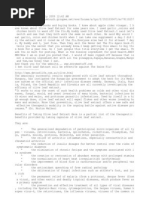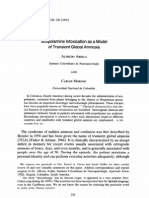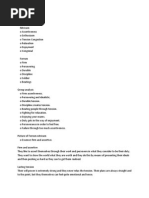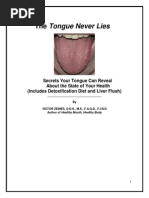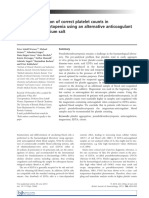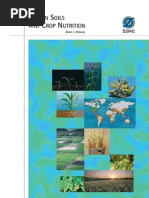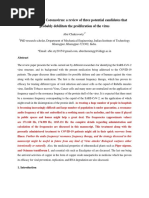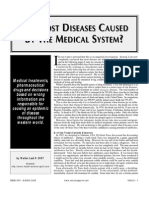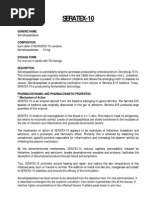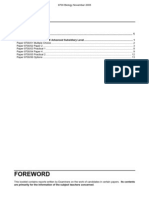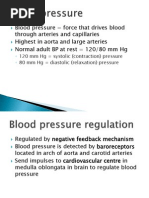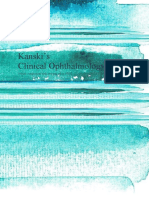Alteratives: Herbal Actions Profile: Alterative
Alteratives: Herbal Actions Profile: Alterative
Uploaded by
Zorica KuskinskaCopyright:
Available Formats
Alteratives: Herbal Actions Profile: Alterative
Alteratives: Herbal Actions Profile: Alterative
Uploaded by
Zorica KuskinskaOriginal Title
Copyright
Available Formats
Share this document
Did you find this document useful?
Is this content inappropriate?
Copyright:
Available Formats
Alteratives: Herbal Actions Profile: Alterative
Alteratives: Herbal Actions Profile: Alterative
Uploaded by
Zorica KuskinskaCopyright:
Available Formats
Herbal Actions Profile: Alterative
Alteratives
The alterative action is likely one of the most important herbal actions in the western system
of herbalism. It is also one of the most vague. In general, a plant containing the alterative
action is said to open the channels of elimination of the body and affect the bodies natural
detoxification processes. It’s important to consider here that our body works to detoxify not
just things like pesticides, chemicals or environmental toxins like many people think, rather it
is the normal waste products associated with metabolism. This includes proteinaceous wastes,
cellular debris, hormones and other standard byproducts of our bodies metabolic processes.
So if we are thinking about the various channels of elimination of the body, we see that there
are 5 primary organ systems responsible for throwing off waste products. They are:
1. Lungs: Responsible for detoxifying carbon dioxide from the bloodstream, as well as
elimination of airborne materials.
2. Kidneys: Responsible for removal of water soluble waste products through the urine. This
is either directly after cellular metabolism or after further breakdown in the liver and
enhancement of water solubility.
3. Bowels: Responsible for cleansing of physical wastes from the body through the stool.
Many oil soluble toxins are also excreted through the stool via the bile secretions from the
gallbladder.
4. Liver: Major organ of detoxification. The liver is the central hub for preparatory
metabolism as well as the detoxification processes. It excretes fat soluble toxins with the
bile to be secreted into the GI from the gallbladder. The liver also makes certain
compounds water soluble to enhance their elimination from the kidneys with the urine.
5. Skin: It’s really easy to overlook the skin, but it is actually the largest organ of
detoxication! Our body secretes both water and oil soluble toxins through the sebaceous
and oily secretions of the skin, as well as water soluble ones through the sweat. It is quite
common for people with depressed metabolism and “bad blood” to display the need for
alteratives via chronic skin conditions such as eczema.
Thus with our definition of alteratives so far, we see that our remedies will have affinities for
these various organ systems, either singularly or in combination. This leads to a very complex
and diverse range of plants under the alterative category.
Another way of defining this action is through metabolism. The old doctors described an
alterative as any remedy which “alters” or adjusts the metabolic processes of the body.
Metabolism in general has 2 parts: the anabolic phase builds up tissue through digestion,
absorption and utilization of nutrients from for (thus digestion is a major factor here) and the
catabolic phase breaks down the waste products and eliminates them from the body. Thus an
alterative is any remedy that would affect the bodies capacity to digest, absorb, distribute, and
utilize nutrition as well as properly break down, metabolize, and excrete the waste products.
This is a pretty big process which involves many different organs, systems, tissues and
physiological processes- making our definition and delineation of alteratives even more vague!
But, for the most part, they tend to have the strongest affinity for the catabolic side of
metabolism, meaning that they tend to work more on the detoxification and elimination side of
Materia Medica Monthly Herbal Actions Profile Page 1
Herbal Actions Profile: Alterative
the process. That being said there are a small handful of remedies that act to help nourish the
tissues through their nutrient content- interestingly enough a handful of these also act on the
catabolic side!
So what are they used for? Where would you think to utilize an alterative medicine? The old
doctors in the west called it “bad blood syndrome,” which was oftentimes associated with an
accumulation of waste products and toxins stagnating within the tissues and congesting the
channels of elimination. As such, we would generally see dampness accumulating (edema,
swellings, puffiness, swollen lymph nodes), poor sluggish digestion (constipation), chronic
skin conditions (eczema, acne, boils), infections (low grade fever, septicemia, chronic
infections, low immunity), chronic fatigue and low energy levels, to the most severe which
would be things like tumors, malignancies, and cancer.
What’s important to consider here is that it is most often associated with an accumulation of
dampness within the tissues of the body. Because the vital force is intelligent (brilliant
actually), it strives to cleanse this dampness from the system by initiating an inflammatory
response to “burn and purge” the fluids from the system. This oftentimes leads to a secondary
heat response, thus the general energetic constellation that most often calls for alteratives is
the pattern referred to as “damp heat.”
This concept of “bad blood” goes all the way back to ancient Greek medicine and has it’s
reflections in almost every other medical traditions from around the world. In Ayurveda they
describe it as the accumulation of ama, a thick congealed sticky phlegm that congests and
accumulates within the channels of the body (both physical and energetic). In Chinese
Medicine they simply called it damp accumulation, and when the heat manifests it would
“damp/heat.” Samuel Thomson described this state as an accumulation of canker within the
tissues, the Greeks called it “humors in the blood,” and the Physiomedicalists referred to it as
the damp/stagnation tissue state.
Knowing this pattern in which they are best used for is the key to using alterative, or
detoxifying plants, holistically and intelligently. It’s critical to understand that most, if not all,
of these plants tend to be draining and drying to the constitution. This is naturally what you
want since the core pattern being treated is dampness. Generally speaking, they make you
defecate more, urinate more, sweat more, and open everything up to move out of the body.
Thus alterative plants are typically always contraindicated in excessively dry
constitutions. There are certainly exceptions to this rule, but it is a good one to follow
initially.
This is important because what we see in the modern western world and alterative products
industry is the detoxification craze where everyone thinks they are full of pesticides, parasites,
and heavy metals and need to detox. Thus they turn to many of our alterative remedies which
are known to “detoxify” the body, but don’t take into consideration the older definitions of
what toxicity was, and more importantly the constitutional factors involved in extensive or
extended use of these plants. It’s very common for people to damage their constitution from
misusing this class of materia medica.
Materia Medica Monthly Herbal Actions Profile Page 2
Herbal Actions Profile: Alterative
So with all of that, let’s take a look at a list of some alterative herbs commonly used in western
herbalism:
Alfalfa (Medicago sativum)
Blue Flag (Iris versicolor)
Boneset (Eupatorium perfoliatum)
Burdock root and seed (Arctium lappa)
Calendula (Calendula officinalis)
Cascara Sagrada (Rhamnus purshiana)
Cayenne (Capsicum annuum)
Celery seed (Apium graveolens)
Cleavers (Galium aparine)
Dandelion leaf and root (Taraxacum officinale)
Echinacea root and flower (Echinacea purpurea, E. angustifolia)
Elder flower (Sambucus spp.)
Figwort (Scrophularia nodosa)
Fringe Tree (Chionanthus virginicus)
Garlic (Allium sativum)
Ginger (Zingiber officinale)
Goldenseal (Hydrastis canadensis)
Horsetail (Equisetum arvense)
Juniper (Juniperus communis)
Kelp (Fucus vesiculosis)
Nettle leaf (Urtica dioica)
Oregon Grape (Mahonia aquifolium)
Poke (Phytolacca decandra)
Prickly Ash (Zanthoxylum americanum)
Red Clover (Trifolium pratense)
Red Raspberry (Rubus ideaus)
Red Rhubarb (Rheum spp.)
Red Root (Ceanothus americanus)
Rosemary (Rosmarinus officinalis)
Sarsaparilla (Smilax spp.)
Sassafras (Sassafras albidum)
Senna (Senna alexandria)
Wild Indigo (Baptisia tinctoria)
Yarrow (Achillea millefolium)
Yellow Dock (Rumex crispus)
Overwhelmed? I usually am when I see huge lists like that! When you see an herb like
Echinacea next to plants like Poke root and Kelp and Alfalfa and Garlic and Burdock it’s easy
to start scratching your head like “huh? what do all of these plants have in common?” You use
Poke root in a very different way than you use Kelp or Alfalfa. But many books just leave their
Materia Medica Monthly Herbal Actions Profile Page 3
Herbal Actions Profile: Alterative
list of alterative herbs there and you are left to figure out the rest on your own. I do not like
huge lists of herbs like this. It lacks specificity and precision. It leaves you hanging in terms
of exactly how do you select an alterative that is specific for your client!
Taking all of this into consideration, I have found it to be extremely beneficial to further
divide and break down the alterative class of herbal medicines into sub-categories based on
the plants specific organ, system and tissue affinities, as well as any secondary actions they
might have. This helps you to select your remedies more strategically and intelligently based
on the specific needs of your client and finding something suitable for them, as opposed to
going for a general shotgun approach.
Thus, we can further break down our alterative materia medica into the following secondary
categories. I will list some materia medica under each category, as well as their effects upon
temperature and moisture so you can get a sense of the energetics of the herbs. These lists are
excellent resources for you to consult during formulation, remedy selection for a client, as well
as to guide your studies in materia medica.
Diuretic Alteratives
These remedies have an influence upon water excretion via the kidneys and thus help
to drain fluids systemically from the body.
Blue Flag (Iris versicolor) cold and dry
Burdock (Arctium lappa) neutral and amphoteric*
Celery seed (Apium graveolens) warm and dry
Cleavers (Galium aparine) cool and moist
Dandelion leaf (Taraxacum officinale) cool and dry
Elder flower (Sambucus spp.) cool and dry
Horsetail (Equisetum arvense) neutral and dry
Juniper (Juniperus communis) hot and dry
Nettle leaf (Urtica dioica) slightly cool and dry
Yarrow (Achillea millefolium) cool and dry
Hepatic Alteratives
These remedies impact the liver, primarily through their bitter tonic actions, which also
stimulates digestion.
Blue Flag (Iris versicolor) cold and dry
Burdock (Arctium lappa) neutral and amphoteric*
Calendula (Calendula officinalis) warm and dry
Dandelion root (Taraxacum officinale) cold and dry
Fringe Tree (Chionanthus virginicus) cold and dry
Goldenseal (Hydrastis canadensis) cold and dry
Oregon Grape (Mahonia aquifolium) cold and dry
Red Root (Ceanothus americanus) cold and dry
Materia Medica Monthly Herbal Actions Profile Page 4
Herbal Actions Profile: Alterative
Yellow Dock (Rumex crispus) cold and dry
Diaphoretic Alteratives
These plants help to promote sweating during fever, but can also be used for
detoxification through the skin.
Boneset (Eupatorium perfoliatum) cold and dry
Burdock seed (Arctium lappa) warm and dry/moist*
Calendula (Calendula officinalis) warm and dry
Cayenne (Capsicum annuum) hot and dry
Elder flower (Sambucus spp.) cool and dry
Garlic (Allium sativum) hot and dry
Sarsaparilla (Smilax spp.) warm and dry
Sassafras (Sassafras albidum) hot and dry
Immunological Alteratives
These remedies affect the bodies capacity to tolerate metabolic waste products by
enhancing immune function, containing antimicrobial properties, and/or lymphatic/
diaphoretic actions.
Boneset (Eupatorium perfoliatum) cold and dry
Echinacea (Echinacea angustifolia) cool and dry
Elder (Sambucus spp.) cool and dry
Garlic (Allium sativum) hot and dry
Wild Indigo (Baptisia tinctoria) cold and dry
Lymphatic Alteratives
These remedies have their impact upon the lymphatic system, helping to reduce
swelling and drain the lymph. Many will also influence immunity, as the immune
system is strongly rooted in the lymph.
Blue Flag (Iris versicolor) cold and dry
Calendula (Calendula officinalis) warm and dry
Cleavers (Galium aparine) cool and moist
Echinacea (Echinacea angustifolia) cool and dry
Figwort (Scrophularia nodosa) cold and dry
Poke (Phytolacca decandra) cold and dry
Red Clover (Trifolium pratense) cool and moist
Red Root (Ceanothus americanus) cool and dry
Wild Indigo (Baptisia tinctoria) cold and dry
Materia Medica Monthly Herbal Actions Profile Page 5
Herbal Actions Profile: Alterative
Bowel Alteratives
See materia medica listed above under hepatic alteratives. Because all of those
remedies are bitter tonics as well they tend to increase digestion and bowel movements.
Also under here would be stimulant laxatives, such as:
Cascara Sagrada (Rhamnus purshiana) dry
Red Rhubarb (Rheum spp.) dry
Senna (Senna alexandria) dry
Yellow Dock (Rumex crispus) cool and dry
Skin Alteratives
These are remedies that are commonly used for chronic skin conditions such as
eczema.
Burdock (Arctium lappa) neutral and amphoteric*
Calendula (Calendula officinalis) warm and dry
Cleavers (Galium aparine) cool and moist
Dandelion root (Taraxacum officinale) cool and dry
Elder flower (Sambucus spp.) cool and dry
Figwort (Scrophularia nodosa) cool and dry
Oregon Grape (Mahonia aquifolium) cool and dry
Red Clover (Trifolium pratense) cool and moist
Sarsaparilla (Smilax spp.) warm and dry
Yellow Dock (Rumex crispus) cool and dry
Circulatory Alteratives
These are essentially circulatory stimulants. Some are more specific for detoxification,
but in general increasing circulation during alterative therapy is critical to keep
everything moving through the system and to the channels of elimination.
Cayenne (Capsicum annuum) hot and dry
Garlic (Allium sativum) hot and dry
Ginger (Zingiber officinale) warm and dry
Prickly Ash (Zanthoxylum americanum) hot and dry
Rosemary (Rosmarinus officinalis) warm and dry
Sarsaparilla (Smilax spp.) warm and dry
Sassafras (Sassafras albidum) hot and dry
Nutritive Alteratives
Remember that alteratives act upon metabolism, which includes the nutritional/
anabolic side. These remedies contain a high nutrient content.
Materia Medica Monthly Herbal Actions Profile Page 6
Herbal Actions Profile: Alterative
Alfalfa (Medicago sativum) neutral and dry
Horsetail (Equisetum arvense) neutral and dry
Kelp (Fucus vesiculosis) neutral and dry
Nettle leaf (Urtica dioica) slightly cool and dry
Red Clover (Trifolium pratense) slightly cool and moist
Red Raspberry (Rubus ideaus) slightly cool and dry
__________________________
These are some of the important delineations amongst our alterative materia medica
that are important to consider when selecting remedies that will be appropriate for
your client. It is important to think about first off whether they are constitutionally
appropriate and whether the person does indeed need alteratives to begin with. From
there it’s important to consider the specific affinities and actions that you want your
herb(s) to have and use these charts to find some suitable that match what you are
looking for.
Generally speaking, I think it’s a good idea to have general alterative formulas tend to
all of the primary channels of elimination. From there the formula can be adjusted and
tailored to suit the specific needs of the person by making certain herbs more central
and others more as supports. It is also important to remember that most alterative
plants are drying, thus you must always assess your client and make sure they are not
starting to have signs of excessive dryness (dry mouth, eyes, bowels, skin, etc.) or if
they start to have any sort of spasm, cramping, nervous irritability etc. These are all
signs of constitutional imbalances occurring and the necessity to tone down the
alteratives, reformulate with more moistening remedies, or change up someone’s
protocol in a way that is more suitable for them.
Materia Medica Monthly Herbal Actions Profile Page 7
You might also like
- Humaworm BookDocument108 pagesHumaworm Bookross nagot0% (1)
- Functional Magnetic Resonance Imaging. 3rd Edition. ISBN 0878936270, 978-0878936274Document23 pagesFunctional Magnetic Resonance Imaging. 3rd Edition. ISBN 0878936270, 978-0878936274janislattonawe93% (15)
- Wallach Published WorksDocument4 pagesWallach Published Worksidonotconsent1957No ratings yet
- ORIVEDA L+ - Lion's Mane Extract - Information LeafletDocument2 pagesORIVEDA L+ - Lion's Mane Extract - Information LeafletDirac Delta0% (1)
- NLP Master Practioner McKenna Breen Bandler March 1999 Course NotesDocument21 pagesNLP Master Practioner McKenna Breen Bandler March 1999 Course NotesBogdan MateiNo ratings yet
- Nursing Care PlanDocument5 pagesNursing Care PlandorkylovelyNo ratings yet
- Olive Leaf ExtractDocument9 pagesOlive Leaf ExtractCristina100% (1)
- Solidos Do Mar Trace Elements AcresUSADocument4 pagesSolidos Do Mar Trace Elements AcresUSAjocaferreira24100% (1)
- MB 0457Document14 pagesMB 0457Isabel RosendoNo ratings yet
- PsoriasisDocument0 pagesPsoriasisaurax143No ratings yet
- What Is Organic Sulfur? 9Document9 pagesWhat Is Organic Sulfur? 9Roger Adams100% (2)
- Q & A Information About Toxins and Liquid Zeolites 21ppDocument21 pagesQ & A Information About Toxins and Liquid Zeolites 21ppAna LuNo ratings yet
- !colloidal SilverDocument1 page!colloidal SilverAsheenNo ratings yet
- ROFES Brochure EnglishDocument34 pagesROFES Brochure EnglishPhan Gia HuấnNo ratings yet
- ChildhoodDocument23 pagesChildhoodkrissyNo ratings yet
- Scopolamine Intoxication As A Model of Transient Global AmnesiaDocument10 pagesScopolamine Intoxication As A Model of Transient Global AmnesiaDakotaJimNo ratings yet
- Cancer and CarcinosinDocument12 pagesCancer and CarcinosinDr. Nur-E-Alam RaselNo ratings yet
- Iron Toxic Heavy Metals Fact SheetDocument1 pageIron Toxic Heavy Metals Fact SheetosumexNo ratings yet
- Chlorophyll - English VersionDocument12 pagesChlorophyll - English Versionqle2004No ratings yet
- 1 Chelation Therapy ® - Longevity Centres of America PDFDocument12 pages1 Chelation Therapy ® - Longevity Centres of America PDFSibia SukhbindarNo ratings yet
- ATP Blog - Things To Know About Fulvic AcidDocument17 pagesATP Blog - Things To Know About Fulvic Acidatpfacebook100% (1)
- Ferrum NitricumDocument14 pagesFerrum Nitricummiadelfior100% (1)
- Hypo and Hyperbaric PhysiologyDocument43 pagesHypo and Hyperbaric PhysiologyPhindile SkhonaNo ratings yet
- TurpentineDocument14 pagesTurpentinegaryfullerNo ratings yet
- Nano Colloidal SilverDocument6 pagesNano Colloidal Silvernanocolloids100% (1)
- Full download Hypothyroidism Hypo thyroidism The unsuspected illness 1st Edition Broda Barnes pdf docxDocument78 pagesFull download Hypothyroidism Hypo thyroidism The unsuspected illness 1st Edition Broda Barnes pdf docxsuksijatoi100% (2)
- Thyroid Function and Phytotherapy - Rosalind BlackwellDocument14 pagesThyroid Function and Phytotherapy - Rosalind BlackwellCPP-libraryNo ratings yet
- Colloidal Silver Vs Silver Sol: What's The DifferenceDocument4 pagesColloidal Silver Vs Silver Sol: What's The DifferenceALKESWWNo ratings yet
- Oxidative Phosphorylation and Mitochondrial Physiology - A Critical Review of Chemiosmotic Theory and Reinterpretation by The Association-Induction Hypothesis (Ling)Document68 pagesOxidative Phosphorylation and Mitochondrial Physiology - A Critical Review of Chemiosmotic Theory and Reinterpretation by The Association-Induction Hypothesis (Ling)roan2No ratings yet
- Making Coilidal SilverDocument5 pagesMaking Coilidal SilverJan FoxNo ratings yet
- Chemical Constituents and Medical Importance of Galium Aparine - A ReviewDocument6 pagesChemical Constituents and Medical Importance of Galium Aparine - A ReviewBaru Chandrasekhar RaoNo ratings yet
- Vol-1 Essentials For Human Body PDFDocument164 pagesVol-1 Essentials For Human Body PDFVishwanath SomaNo ratings yet
- CancerDocument7 pagesCancerKailash AcharyaNo ratings yet
- The Wild YamDocument6 pagesThe Wild YamReyia ApanteNo ratings yet
- Tongue Pamphlet For Vital BoostDocument11 pagesTongue Pamphlet For Vital BoostRey Johnson100% (6)
- Earthing - Chronic InflammationDocument13 pagesEarthing - Chronic Inflammationsamui11No ratings yet
- From DR Mark Sircus Are ADocument5 pagesFrom DR Mark Sircus Are AMihaela85No ratings yet
- Zeoreport - ZeolitaDocument17 pagesZeoreport - ZeolitageofloNo ratings yet
- A Review of Hydrogen As A New Medical TherapyDocument8 pagesA Review of Hydrogen As A New Medical TherapyfooykokNo ratings yet
- A Colloidal Silver PrimerDocument7 pagesA Colloidal Silver PrimerduhitijeloNo ratings yet
- Vegetarian or Non-Vegetarian?Document3 pagesVegetarian or Non-Vegetarian?nandini_goel1408No ratings yet
- AHCC - Woodlands Patients GuideDocument80 pagesAHCC - Woodlands Patients GuidecrisperezNo ratings yet
- Cannabis in The Treatment of Pediatric EpilepsyDocument3 pagesCannabis in The Treatment of Pediatric EpilepsyArthur GomesNo ratings yet
- Fingernails Condition and Body HealthDocument16 pagesFingernails Condition and Body HealthDevarajan RNo ratings yet
- Magnesium Vs EdtaDocument9 pagesMagnesium Vs Edtaatina putriNo ratings yet
- Oxygen: High Enzymatic Reactivity of Reactive Oxygen SpeciesFrom EverandOxygen: High Enzymatic Reactivity of Reactive Oxygen SpeciesNo ratings yet
- Zinc HealthDocument116 pagesZinc Healthnamkval100% (1)
- Submerged Culture of Phellinus Linteus - mb-36-178 PDFDocument5 pagesSubmerged Culture of Phellinus Linteus - mb-36-178 PDFAmnuay YeangvorakulNo ratings yet
- Tender Coconut Water - Natures Elixir To MankindDocument6 pagesTender Coconut Water - Natures Elixir To MankindAran MuthNo ratings yet
- The Professional Practice of Teaching in New Zealand 6th EditionDocument352 pagesThe Professional Practice of Teaching in New Zealand 6th Editionarianaluo710No ratings yet
- Farm Bio-Security With Nano Silver Hydrogen Peroxide Based Alstasan SilvoxDocument2 pagesFarm Bio-Security With Nano Silver Hydrogen Peroxide Based Alstasan SilvoxSilver Hydrogen PeroxideNo ratings yet
- Nattokinase and Cardiovascular HealthDocument8 pagesNattokinase and Cardiovascular HealthIhorNo ratings yet
- Safety and Efficacy of Shilajit (Mumie, Moomiyo)Document5 pagesSafety and Efficacy of Shilajit (Mumie, Moomiyo)Alejandro Müller100% (1)
- Cellular and Molecular Actions of Methylene Blue in The Nervous System - Oz Et Al.Document25 pagesCellular and Molecular Actions of Methylene Blue in The Nervous System - Oz Et Al.estebanNo ratings yet
- Covid 19 PDFDocument25 pagesCovid 19 PDFRaihandi PutraNo ratings yet
- A History Timeline of Population ControlDocument22 pagesA History Timeline of Population ControlChronosGodNo ratings yet
- Bio-Oxidation and How It Can Help YouDocument1 pageBio-Oxidation and How It Can Help YouDennis UlloaNo ratings yet
- Biodynamic AgricultureDocument3 pagesBiodynamic AgricultureEliane MasonNo ratings yet
- TurmericDocument8 pagesTurmericDaleNo ratings yet
- Cause of DiseaseDocument7 pagesCause of Diseaseparacelsus5100% (1)
- Homeopathic First Aid for Donkeys: Emergencies and Common AilmentsFrom EverandHomeopathic First Aid for Donkeys: Emergencies and Common AilmentsNo ratings yet
- Biology: University of Cambridge International Examinations General Certificate of Education Advanced LevelDocument8 pagesBiology: University of Cambridge International Examinations General Certificate of Education Advanced LevelwegdanNo ratings yet
- Laney 1967Document6 pagesLaney 1967Krupali JainNo ratings yet
- CPG UtiDocument4 pagesCPG UtiNomar NonatoNo ratings yet
- PacemakerDocument24 pagesPacemakerرزاق ابو خالدNo ratings yet
- Seratex-10: Generic NameDocument5 pagesSeratex-10: Generic NameAdit VekariaNo ratings yet
- Discontinuities in Occlusal Relationship and The Regulation of Facial Growth. A Cybernetic ViewDocument10 pagesDiscontinuities in Occlusal Relationship and The Regulation of Facial Growth. A Cybernetic Viewjairo ortiz ambrosioNo ratings yet
- Product and Cell Yield CoefficientsDocument2 pagesProduct and Cell Yield CoefficientsBeauregard100% (1)
- PDFDocument168 pagesPDFrsudhakaran80No ratings yet
- Stress and Coping StrategiesDocument31 pagesStress and Coping StrategiesShubham Jumde0% (1)
- Table 3 1: Properties and Conventions Associated With The Common Amino Acids Found in ProteinsDocument2 pagesTable 3 1: Properties and Conventions Associated With The Common Amino Acids Found in ProteinsJohn Coop CooperNo ratings yet
- 964 Biology (PPU) Semester 2 Topics-SyllabusDocument8 pages964 Biology (PPU) Semester 2 Topics-SyllabusJosh, LRTNo ratings yet
- 2018 WASSCE MAY-JUNE– BIOLOGY PAPER 1Document13 pages2018 WASSCE MAY-JUNE– BIOLOGY PAPER 1kwashiejasielNo ratings yet
- 9700 w05 ErDocument19 pages9700 w05 ErwegdanNo ratings yet
- Blood Gas AnalysisDocument27 pagesBlood Gas AnalysisEvanDwiyanaNo ratings yet
- (Ebook PDF) Neurobiology: A Functional Approach All Chapters Instant DownloadDocument41 pages(Ebook PDF) Neurobiology: A Functional Approach All Chapters Instant Downloadgaibuoffrey100% (5)
- General Pathology QuizDocument2 pagesGeneral Pathology QuizMatt DickoNo ratings yet
- Controversies On The Origin of Life PDFDocument10 pagesControversies On The Origin of Life PDFMarvin OlidNo ratings yet
- Blood Pressure Force That Drives Blood Through Arteries and Capillaries Highest in Aorta and Large Arteries Normal Adult BP at Rest 120/80 MM HGDocument4 pagesBlood Pressure Force That Drives Blood Through Arteries and Capillaries Highest in Aorta and Large Arteries Normal Adult BP at Rest 120/80 MM HGNur Hazwah WahidNo ratings yet
- OjasDocument66 pagesOjasVineeth Vini100% (1)
- Development of The MandibleDocument9 pagesDevelopment of The MandibleHub SciNo ratings yet
- Amoebiasis NCPDocument2 pagesAmoebiasis NCPPamella Pastoral100% (3)
- Jcem 0709Document20 pagesJcem 0709Rao Rizwan ShakoorNo ratings yet
- SA2 Assignment-1: Bal Bharti Public School, Rohini, New DelhiDocument3 pagesSA2 Assignment-1: Bal Bharti Public School, Rohini, New DelhiNeelu Aggarwal SanghiNo ratings yet
- Words Their MeaningsDocument5 pagesWords Their MeaningsDeshpande Sanjeev KumarNo ratings yet
- Kanski's Clinical Ophthalmology: Sebuah Rangkuman Oleh Seorang Calon PPDSDocument42 pagesKanski's Clinical Ophthalmology: Sebuah Rangkuman Oleh Seorang Calon PPDSeclair appleNo ratings yet
- Directions: Reed The Following Questions Carefully and Choose The Letter That Best Describes The AnswerDocument1 pageDirections: Reed The Following Questions Carefully and Choose The Letter That Best Describes The AnswerCHRISTOPHER SCALENo ratings yet
- Calcium Homeostasis and Osteoporosis - McMaster Pathophysiology ReviewDocument8 pagesCalcium Homeostasis and Osteoporosis - McMaster Pathophysiology ReviewEzayu AzeraNo ratings yet






